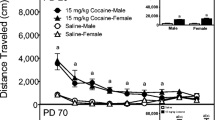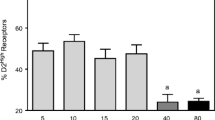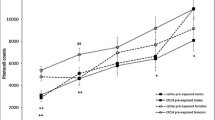Abstract
Rationale
Adolescence is a critical period for drug addiction. Acute stimulant exposure elicits different behavioral responses in adolescent and adult rodents. The same biological differences that mediate age-specific behavioral responsiveness to stimulants in rodents could contribute to increased addiction vulnerability in adolescent humans.
Objectives
This study compared the ability of a single high dose of cocaine (40 mg/kg) to induce behavioral sensitization to a challenge dose of cocaine (10 mg/kg) 24 h later in young adolescent postnatal day 28 (PN 28), mid-adolescent (PN 42), and young adult (PN 65) male rats. Horizontal activity was resolved into ambulatory and non-ambulatory movements. An observational behavioral rating was obtained by recording specific behaviors. We examined if individual behavioral responses to novelty and cocaine correlate with sensitization in each age group.
Results
Single dose cocaine pretreatment induced behavioral sensitization to non-ambulatory horizontal activity, sniffing behaviors, and stereotypies in animals of all ages. Ambulatory sensitization was observed only in the youngest adolescents. Cocaine pretreatment caused greater increases in stereotypies in the young adolescents than in adults. The magnitude of the behavioral response to the initial cocaine treatment was positively correlated with the magnitude of sensitization in individual young adolescents. High levels of novelty-induced ambulatory activity only correlated with the magnitude of ambulatory sensitization in the youngest adolescents.
Conclusions
We conclude that a single high dose of cocaine produces age-specific patterns of behavioral sensitization. Young adolescent rats appear to be more sensitive than adults to some of the behavioral alterations induced by a single high dose of cocaine.






Similar content being viewed by others
References
Ahmed SH, Cador M (2006) Dissociation of psychomotor sensitization from compulsive cocaine consumption. Neuropsychopharmacology 31:563–571
Andersen SL (2002) Changes in second messenger cyclic AMP signaling during development may underlie motoric symptoms in attention deficit/hyperactivity disorder (ADHD). Behav Brain Res 130:197–201
Anderson SL, Teicher MH (2000) Sex differences in dopamine receptors and their relevance to ADHD. Neurosci Biobehav Rev 24:137–141
Andersen SL, Thomphson AT, Rutstein M, Hostetter JC, Teicher MH (2002) Dopamine receptor pruning in prefrontal cortex during the periadolescent period in rats. Synapse 37:167–169
Arnett J (1992) Reckless behavior in adolescence: a developmental perspective. Dev Rev 12:339–373
Badiani A, Oats MM, Day HEW, Watson SJ, Akil H, Robinson TE (1998) Amphetamine-induced behavior, dopamine release, and c-fos expression: modulation by environmental novelty. J Neurosci 18:10579–10593
Badiani A, Oats MM, Day HEW, Watson SJ, Akil H, Robinson TE (1999) Environmental modulation of amphetamine-induced c-fos expression in D1 vs D2 striatal neurons. Behav Brain Res 103:203–209
Barnes GM, Welte JW (1983) Predictors of alcohol use among college students in New York State. J Am Coll Health 31:150–157
Belluzzi JD, Lee AG, Oliff HS, Leslie FM (2004) Age-dependent effects of nicotine on locomotor activity and CPP in rats. Psychopharmacology 174:389–395
Bolanos CA, Glatt SJ, Jackson D (1998) Subsensensitivity to dopaminergic drugs in periadolescent rats: a behavioral and neurochemical analysis. Dev Brain Res 111:25–33
Bowman BP, Kuhn CM (1996) Age-related differences in the chronic and acute response to cocaine in the rat. Dev Psychobiol 29:597–611
Brandon CL, Marinelli M, Baker LK, White FJ (2001) Enhanced reactivity and vulnerability to cocaine following methylphenidate treatment in adolescent rats. Neuropsychopharmacology 25:651–661
Brebner K, Wong TP, Liu L, Liu Y, Campsall P, Gray S, Phelps L, Phillips AG, Wang YT (2005) Nucleus accumbens long-term depression and the expression of behavioral sensitization. Science 310:1340–1343
Carey RJ, Gui J (1998) Cocaine conditioning and cocaine sensitization: what’s the relationship? Behav Brain Res 92:67–76
Caster JM, Walker QD, Kuhn CM (2005) Enhanced behavioral response to binge cocaine in adolescent rats. Psychopharmacology 183:218–225
Cervo L, Samanin R (1995) Effects of dopaminergic and glutamatergic receptor antagonists on the acquisition and expression of cocaine conditioning and place preference. Brain Res 673:242–250
Chambers RA, Taylor JR, Potenza MN (2003) Developmental neurocircuitry of motivation in adolescence: a critical period of addiction vulnerability. Am J Psychiatry 160:1041–1052
Chefer VI, Zakharova I, Shippenburg TS (2003) Enhanced responsiveness to cocaine and novelty is associated with decreased basal dopamine uptake and release in the nucleus accumbens: quantitative microdialysis in rats under transient conditions. J Neurosci 23:3076–3084
Clark DB, Kirisci L, Tarter RE (1998) Adolescent versus adult onset and the development of substance use disorders. Drug Alcohol Depend 49:115–121
Collins SL, Izenwasser S (2002) Cocaine differentially alters behavior and neurochemistry in periadolescent versus adult rats. Dev Brain Res 138:27–34
Collins SL, Izenwasser S (2004) Chronic nicotine differentially alters cocaine-induced locomotor activity in adolescent vs adult male and female rats. Neuropharmacology 46:349–362
Crombag HS, Badiani A, Chan J, Dell’Orco J, Dineen SP, Robinson TE (2001) The ability of environmental context to facilitate psychomotor sensitization to amphetamine can be dissociated from its effects on acute drug responsiveness and conditioning. Neuropsychopharmacology 24:680–690
Gelbard HA, Teicher MH, Faedda G, Baldessarini RJ (1989) Postnatal development of dopamine D1 and D2 receptor sites in rat striatum. Dev Brain Res 49:123–130
Goeders NE (2002a) Stress and cocaine addiction. J Pharmacol Exp Ther 301:785–789
Goeders NE (2002b) The HPA axis and cocaine reinforcement. Psychoneuroendocrinology 27:13–33
Grant BF, Dawson DA (1997) Age at onset of alcohol use and its association with DSM-IV alcohol abuse and dependence: results from the National Longitudinal Alcohol Epidemiological study. J Subst Abuse 9:103–110
Grignaschi G, Burbassi S, Zennaro E, Bendotti C, Cervo L (2004) A single high dose of cocaine induces behavioral sensitization and modifies mRNA encoding GluR1 and GAP-43 in rats. Eur J Neurosci 20:2833–2837
Gully JM, Hoover BR, Larson GA, Zahniser NR (2003) Individual differences in cocaine-induced locomotor activity in rats: behavioral characteristics, cocaine pharmacokinetics, and the dopamine transporter. Neuropsychopharmacology 28:2089–2101
Hawkins JD, Graham JW, Maguin E, Abbott R, Hill KG, Catalano RF (1997) Exploring the effects of age of alcohol use initiation and psychosocial risk factors on subsequent alcohol misuse. J Stud Alcohol 58:280–290
Hooks MS, Jones GH, Smith AD, Neill DB, Justice JBJ (1991) Individual differences in locomotor activity and sensitization. Pharmacol Biochem Behav 38:467–470
Kelly PH, Iversen SD (1976) Selective 6OH-DA induced destruction of mesolimbic dopamine neurons: abolition of psychostimulant-induced locomotor activity in rats. Eur J Pharmacol 40:45–56
Kelly PH, Seviour PW, Iversen SD (1975) Amphetamine and apomorphine responses in the rat following 6-OHDA lesions of the nucleus accumbens septi and corpus striatum. Brain Res 94:507–522
Kelley AE, Schochet T, Landry CF (2004) Risk taking and novelty seeking in adolescence: Introduction to part 1. Ann N Y Acad Sci 1021:27–32
Kim HS, Park WK, Jang CG, Oh S (1996) Inhibition by MK-801 of cocaine-induced sensitization, conditioned place preference, and dopamine-receptor supersensitivity in mice. Brain Res Bull 40:201–207
Koob G, Le Moal M (2005) Plasticity of reward neurocircuitry and the ‘dark side’ of drug addiction. Nat Neurosci 8:1442–1444
Kreek MJ, Koob GF (1998) Drug dependence: stress and dysregulation of brain reward pathways. Drug Alcohol Depend 51:23–47
Lanier LP, Isaacson RL (1977) Early developmental changes in the locomotor response to amphetamine and their relation to hippocampal function. Brain Res 126:567–575
Laviola G, Wood RD, Kuhn CM, Francis R, Spear LP (1995) Cocaine sensitization in adult and periadolescent rats. J Pharmacol Exp Ther 275:345–357
Laviola G, Adriani W, Terranova ML, Gerra G (1999) Psychobiological risk factors for vulnerability to psychostimulants in human adolescents and animal models. Neurosci Biobehav Rev 23:993–1010
Le Moal M, Simon H (1991) Mesocorticolimbic dopaminergic network: functional and regulatory roles. Physiol Rev 71:155–234
Lidow MS, Goldman-Rakic PS, Rakic P (1991) Synchronized overproduction of neurotransmitter receptors in diverse regions of the primate cerebral cortex. Proc Natl Acad Sci USA 88:10218–10221
Maggs JL, Almeida DM, Galambos NL (1995) Risky Business: The paradoxical meaning of problem behavior for young adolescents. J Early Adol 15:344–362
Maldonado AM, Kirstein CL (2005a) Cocaine-induced locomotor activity is increased by prior handling in adolescent but not adult female rats. Physiol Behav 86:568–572
Maldonado AM, Kirstein CL (2005b) Handling alters cocaine-induced activity in adolescent but not adult male rats. Physiol Behav 84:321–326
Miczek KA, Mutschler NH (1996) Activational effects of social stress on IV cocaine self-administration in rats. Psychopharmacology 128:256–264
Nelson A, Killcross S (2006) Amphetamine exposure enhances habit formation. J Neurosci 26:3805–3812
Ortiz J, Fitzgerald LW, Lane S, Terwillger R, Nestler EJ (1996) Biochemical adaptations in the mesolimbic dopamine system in response to repeated stress. Neuropsychopharmacology 14:443–452
Piazza PV, Le Moal ML (1996) Pathophysiological basis of vulnerability to drug abuse: role of an interaction between stress, glucocorticoids, and dopaminergic neurons. Annu Rev Pharmacol Toxicol 36:359–378
Piazza PV, Le Moal M (1998) The role of stress in drug self-administration. Trends Pharmacol Sci 19:67–74
Piazza PV, Maccari S, Deminiere J, Le Moal M, Mormede P, Simon H (1991) Corticosterone levels determine individual vulnerability to amphetamine self-administration. Proc Natl Acad Sci USA 88:2088–2092
Post RM, Lockfeld A, Squillace KM, Contel NR (1981) Drug-environment interaction: context dependency of cocaine-induced behavioral sensitization. Life Sci 28:755–760
Post RM, Weiss SRB, Pert A (1987) The role of context and conditioning in behavioral sensitization to cocaine. Psychopharmacol Bull 23:425–429
Post RM, Weiss SRB, Pert A (1988) Cocaine-induced behavioral sensitization and kindling: implications for the emergence of psychopathology and seizures. In: Kalivas PW, Nemeroff CB (eds) The mesocorticolimbic dopamine system. NY Acad Sci, NY, pp 292–308
Robinson TE, Becker JB (1986) Enduring changes in brain and behavior induced by chronic amphetamine administration; a review and evaluation of animal models of amphetamine psychosis. Brain Res Rev 11:157–198
Robinson TE, Berridge KC (1993) The neural basis of drug craving: an incentive-sensitization theory of addiction. Brain Res Rev 18:247–291
Robinson TE, Berridge KC (2001) Incentive-sensitization and addiction. Addiction 96:103–114
Robinson TE, Becker JB, Presty SK (1982) Long-term facilitation of amphetamine-induced rotational behavior and striatal dopamine release produced by a single exposure to amphetamine: sex differences. Brain Res 253:231–241
Schramm-Sapyta NL, Pratt AR, Winder DG (2004) Effects of periadolescent versus adult cocaine exposure on cocaine conditioned place preference and motor sensitization in mice. Psychopharmacology 173:41–48
Seeman P, Bzowej NH, Guan H, Bergeron C, Becker LE, Reynolds GP, Bird ED, Riederer P, Jellinger K, Watanabe S, Tourtellotte WW (1987) Human brain dopamine receptors in children and aging adults. Synapse 1:399–404
Segal DS, Kuczenski R (1999) Escalating dose binge stimulant exposure: relationship between emergent behavioral profile and differential caudate-putamen and nucleus accumbens dopamine response. Psychopharmacology 142:182–192
Spear LP (2000) The adolescent brain and age-related behavioral manifestations. Neurosci Biobehav Rev 24:417–463
Spear LP, Brick J (1979) Cocaine-induced behavior in the developing rat. Behav Neural Biol 26:401–415
Stansfield KH, Kirstein CL (2005) Neurochemical effects of cocaine in adolescence compared to adulthood. Dev Brain Res 159:119–125
Stewart J, Vezina P (1989) Microinjections of SCH-23390 into the VTA and substantia nigra pars reticulata attenuate the development of sensitization to the locomotor activating effects of systemic amphetamine. Brain Res 495:401–406
Tarter RE, Kirisci L, Mezzich A, Cornelius JR, Pajer K, Vanyukov M, Gardner W, Blackson T, Clark D (2003) Neurobehavioral disinhibition in childhood predicts early age at onset of substance use disorder. Am J Psych 160:1078–1085
Teicher MH, Andersen SL, Hostetter JC (1995) Evidence for dopamine receptor pruning between adolescence and adulthood in the striatum but not nucleus accumbens. Dev Brain Res 89:167–172
Tidey JW, Miczek KA (1997) Acquisition of cocaine self-administration after social stress: role of accumbens dopamine. Psychopharmacology 130:203–212
Valjent E, Corvol JC, Pages C, Besson MJ, Maldonado R, Caboche J (2000) Involvement of the extracellular signal-regulated kinase cascade for cocaine-rewarding properties. J Neurosci 20:8701–8709
Vanderschuren LJMJ, Scmidt ED, DeVries TJC, Van Moorsel CAP, Tilders FJH, Schoffelmeer ANM (1999) A single exposure to amphetamine is sufficient to induce long-term behavioral, neuroendocrine, and neurochemical sensitization in rats. J Neurosci 19:9579–9586
Walker QD, Cabassa J, Kaplan K, Shih-Tzung Li, Haroon J, Spohr HA, Kuhn CM (2001) Sex differences in cocaine-stimulated motor behavior: disparate effects of gonadectomy. Neuropsychopharmacology 25:118–130
Wolf ME (1998) The role of excitatory amino acids in behavioral sensitization to psychomotor stimulants. Prog Neurobiol 54:679–720
Acknowledgments
This work was generously supported by NIDA grant #DA09079. These experiments comply with all applicable United States laws and regulations.
Author information
Authors and Affiliations
Corresponding author
Rights and permissions
About this article
Cite this article
Caster, J.M., Walker, Q.D. & Kuhn, C.M. A single high dose of cocaine induces differential sensitization to specific behaviors across adolescence. Psychopharmacology 193, 247–260 (2007). https://doi.org/10.1007/s00213-007-0764-5
Received:
Accepted:
Published:
Issue Date:
DOI: https://doi.org/10.1007/s00213-007-0764-5




